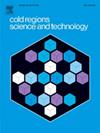Research on the predictability of rock strength under freeze-thaw cycles - A hybrid model of SHAP-IPOA-XGBoost
IF 3.8
2区 工程技术
Q1 ENGINEERING, CIVIL
引用次数: 0
Abstract
As environmental dynamics increasingly influence the stability of engineering materials, accurately predicting sandstone strength under freeze-thaw cycles has become essential. This study presents a new method, IPOA-XGBoost, integrating an improved Pelican Optimization Algorithm (IPOA) with Extreme Gradient Boosting (XGBoost) to accurately forecast sandstone strength in freeze-thaw environments. Principal component analysis (PCA) is employed for reducing data dimensionality, while IPOA optimizes the hyperparameters of the XGBoost model. Experimental findings show that the IPOA-XGBoost model outperforms traditional methods, delivering improved accuracy and robustness in both training and testing datasets. To address the “black box” challenge of machine learning models, SHAP (SHapley Additive exPlanations) values are applied to clarify the impact of individual features on prediction outcomes, validating SHAP's reliability as an interpretive tool. The findings highlight the importance of strain rate (SR), impact pressure (IP), and confining pressure (CP) as key variables affecting sandstone strength predictions. This methodology provides significant insights for predicting sandstone strength in applied engineering contexts.
冻融循环作用下岩石强度可预测性研究——SHAP-IPOA-XGBoost混合模型
随着环境动力学对工程材料稳定性的影响越来越大,准确预测冻融循环作用下砂岩的强度变得至关重要。该研究提出了一种新的方法,IPOA-XGBoost,将改进的鹈鹕优化算法(IPOA)与极限梯度增强(XGBoost)相结合,以准确预测冻融环境下砂岩的强度。采用主成分分析(PCA)对数据进行降维,IPOA对XGBoost模型的超参数进行优化。实验结果表明,IPOA-XGBoost模型优于传统方法,在训练和测试数据集上都提供了更高的准确性和鲁棒性。为了解决机器学习模型的“黑箱”挑战,应用SHAP (SHapley Additive exPlanations)值来澄清单个特征对预测结果的影响,验证SHAP作为解释工具的可靠性。研究结果强调了应变率(SR)、冲击压力(IP)和围压(CP)作为影响砂岩强度预测的关键变量的重要性。该方法为应用工程环境下预测砂岩强度提供了重要见解。
本文章由计算机程序翻译,如有差异,请以英文原文为准。
求助全文
约1分钟内获得全文
求助全文
来源期刊

Cold Regions Science and Technology
工程技术-地球科学综合
CiteScore
7.40
自引率
12.20%
发文量
209
审稿时长
4.9 months
期刊介绍:
Cold Regions Science and Technology is an international journal dealing with the science and technical problems of cold environments in both the polar regions and more temperate locations. It includes fundamental aspects of cryospheric sciences which have applications for cold regions problems as well as engineering topics which relate to the cryosphere.
Emphasis is given to applied science with broad coverage of the physical and mechanical aspects of ice (including glaciers and sea ice), snow and snow avalanches, ice-water systems, ice-bonded soils and permafrost.
Relevant aspects of Earth science, materials science, offshore and river ice engineering are also of primary interest. These include icing of ships and structures as well as trafficability in cold environments. Technological advances for cold regions in research, development, and engineering practice are relevant to the journal. Theoretical papers must include a detailed discussion of the potential application of the theory to address cold regions problems. The journal serves a wide range of specialists, providing a medium for interdisciplinary communication and a convenient source of reference.
 求助内容:
求助内容: 应助结果提醒方式:
应助结果提醒方式:


